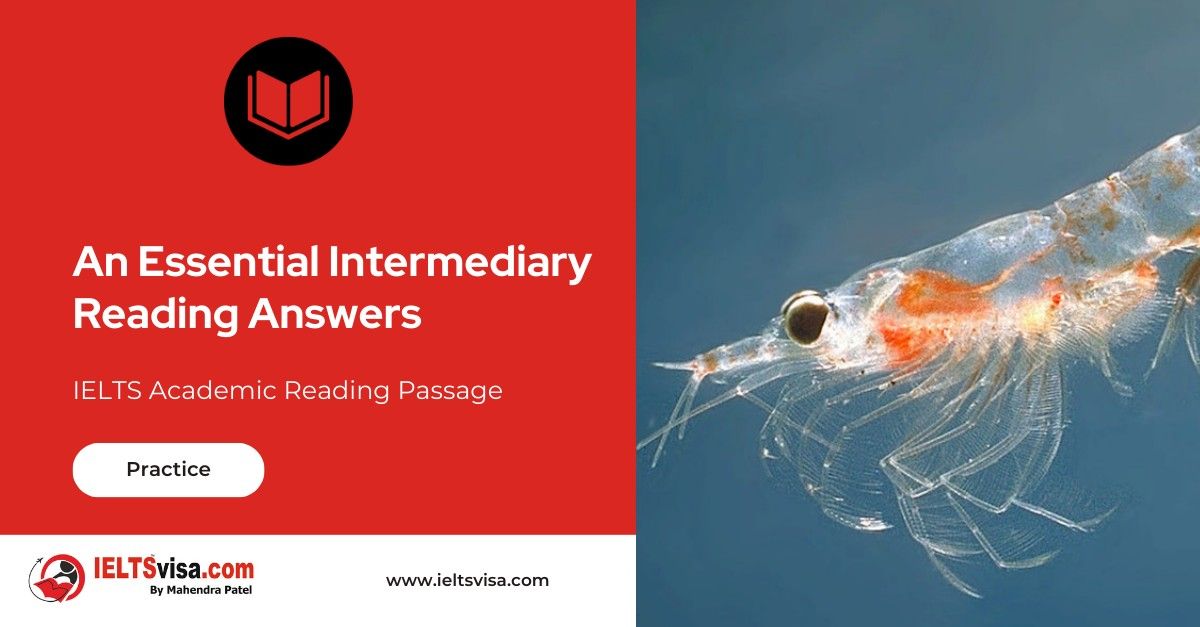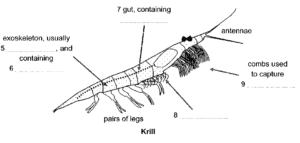An Essential Intermediary Reading Answers
IELTS Academic Reading Passage
There is a strange irony about the blue whale. With fully grown adults reaching up to 30 metres long, and weighing in at almost 200 tons, it is not only the largest animal in the world, but also the largest to have ever existed. Yes, not even the most imposing of the dinosaurs from the Jurassic era can match this sleek streamlined aquatic mammal in scale. So, where is the irony? It lies in the fact that this huge beast feeds primarily on one of the smallest life forms in the oceans, a tiny crustacean known as krill.
Krill live in every ocean of the world. They thus come in many varieties, although all sporting a similar shrimp-like appearance, with an exoskeleton divided into three parts, and with two large antennae at the front, and pairs of legs running down the underside. These creatures are distinguishable from shrimp by their gills, which are externally mounted, and resemble rows of fibrous combs alongside their bodies. Another oddity is that their exoskeleton is usually transparent. This, and their small size, lead to the deceptive conclusion that they are an insubstantial presence, of little importance, until one is informed that an adult blue whale can consume almost 40 million krill, with a total weight of 3,600 kilograms, in just one day.
It is this, their huge numbers, which makes these mysterious ghost-like crustaceans so important. Just looking at one species, the Antarctic krill, their collective weight (or bio-mass) is estimated to be about 500 million tons. Putting this another way, that is over twice the weight of all human beings currently on Earth. Some scientists estimate that, each year, as much as half of this is eaten by whales, seals, penguins, squid, and fish, illustrating that krill constitute an enormous food resource for other animals. The question is whether humans can get in on the act.
Antarctic krill are the largest species, at six centimeters. Most other species are about two centimeters, and this makes them awkward to catch. Very fine fishing nets are needed, but these are difficult to drag through the water, quickly clogged, and easily broken. In addition, when lifted in large piles, the delicate krill crush each other, forcing out their internal fluids. They must also be peeled due to the dangerously high levels of fluoride in their exoskeleton, and finally, they must be quickly prepared and frozen due to the strong enzymes in their gut, which would otherwise cause rapid putrefaction. It is problems such as these which have limited processed krill to being mostly used as fish food in aquariums or aquaculture, or bait in commercial fishing operations, but otherwise very much out of the public’s mind.
Seafood-loving Japan is the only country in the world in which some krill end up on the table. The boiled, peeled, then frozen tail-meat is sold on the market, and there is some lower-grade krill-paste used as a food flavouring or colouring agent. These products originate from the small North-Pacific krill, yet it is the large Antarctic species which would seem to offer the best commercial prospects, and perhaps a more appetising meal. The majority of krill trawlers thus target the waters around coastal Antarctica, but it is a remote region, subject to harsh weather conditions, making operations there difficult and expensive, as well as raising issues of the ecological consequences, especially given the importance of krill as the basis of the food chain in that pristine and untouched environment.
Yet to explore this food chain fully, one must go smaller still. Krill themselves are filter feeders, using very fine comb-like appendages on the front of their bodies to extract microscopic organisms known as phytoplankton. These live in almost every body of water in the world, but only in the well-lit surface layers, since these organisms need exposure to sunlight, from which they obtain their energy. In the same way that plants on land are ultimately the basis of all food chains there, so too are phytoplankton in the oceans. Since krill exist in such large numbers, logically then, their primary food source must be even more numerous. There is, in fact, so much phytoplankton that their collective photosynthesis accounts for up to half of the oxygen produced in the world.
However, as with krill, the vast numbers of phytoplankton live unnoticed and unobserved. Their presence can only be indirectly deduced when they are pressed together by currents, where there can be correspondingly high concentrations of krill feeding on them. This can similarly result in the usually solitary blue whales being found together, and revealing one of the most remarkable and elusive food chains in nature: from phytoplankton, to krill, to the blue whale. In other words, from the tiniest elements in nature, in two short steps leading to a mighty and awe-inspiring leviathan of the deep, the largest animal that has ever existed. And the small ghostly krill are the essential intermediary in this wondrous process.
Questions 1-4
Do the following statements agree with the information given in Reading Passage One?
Write
|
TRUE |
if the statement agrees with the information |
|
FALSE |
if the statement contradicts the information |
|
NOT GIVEN |
If there is no information on this |
1 Some dinosaurs were bigger than the blue whale.
2 The blue whale does not only eat krill.
3 Some krill are smaller than shrimp.
4 There are about 500 million tons of krill in the ocean.
Questions 5-9
Complete the diagram.
Choose ONE WORD from the passage for each answer.

- ………………….
- ………………….
- ………………….
- ………………….
- ………………….
Questions 10-13
Choose the correct letter, A, B, C, or D.
10. Fishing for krill is
A. not too difficult.
B. mostly done in Antarctic waters.
C. Mostly done in Japanese waters.
D. Done with large fishing nets.
11. Krill
A. move like ghosts.
B. are processed soon after capture.
C. are mostly used for human consumption.
D. come in two varieties.
12. Phytoplankton
A. outnumber krill.
B. produce over half of the oxygen in the world.
C. can be seen with the naked eye.
D. can live anywhere in the ocean.
13. Blue whales
A. are a very large species of fish.
B. can weigh 200 tons.
C. prefer to be alone.
D. are in the middle of a food chain.

Solution For: An Essential Intermediary
Reading Answers
| 1 FALSE | 2 TRUE |
| 3 NOT GIVEN | 4 FALSE |
| 5 transparent | 6 fluoride |
| 7 enzymes | 8 gills |
| 9 phytoplankton | 10 B |
| 11 B | 12 A |
| 13 C |
Review and Practice
- Regularly practice with IELTS reading samples and time yourself to get used to the pressure of the exam.
- Review your mistakes to understand where you went wrong and how to avoid similar errors in the future.
Our Books
Master IELTS Speaking Part 1
IELTS Writing Task 1 Book
IELTS Writing Task 2 Book
An Essential Intermediary Reading Answers Explanation
Comin Soon
Practice IELTS Other Modules
IELTS Listening
The IELTS Listening test assesses how well you can understand spoken English in various contexts. It lasts about 30 minutes and is divided into four sections with a total of 40 questions. The listening tasks become increasingly difficult as the test progresses.
IELTS Academic Reading
The IELTS Academic Reading section assesses your ability to understand and interpret a variety of texts in academic settings. It is designed to evaluate a range of reading skills, including skimming for gist, reading for main ideas, reading for detail, understanding inferences, and recognizing a writer's opinions and arguments.
IELTS Speaking
The IELTS Speaking test assesses your ability to communicate in English on everyday topics. It lasts 11-14 minutes and consists of three parts: introduction, cue card, and a discussion based on the cue card topic.
IELTS General Reading
IELTS General Reading tests your ability to understand and interpret various types of texts. Here are some key areas and types of content you can expect to encounter in the reading section, along with tips for effective preparation.
IELTS Academic Writing Task 1
In IELTS Academic Writing Task 1, you are presented with a visual representation of information, such as graphs, charts, tables, or diagrams, and you are required to summarize, compare, or explain the data in your own words.
IELTS General Writing Task 1
In IELTS General Writing Task 1, you are required to write a letter based on a given situation. The letter can be formal, semi-formal, or informal, depending on the prompt. Here’s a breakdown of the key components to include in your letter
IELTS Academic Writing Task 2
In IELTS Academic Writing Task 2, you are required to write an essay in response to a question or topic. Here’s a guide to help you understand the essential elements of this task
IELTS Exam Tips
To succeed in the IELTS exam, practice regularly, familiarize yourself with the test format, improve your vocabulary, develop time management skills, and take mock tests to build confidence.
Grammer for IELTS
Grammar is the foundation of effective communication in English. Understanding tense usage, subject-verb agreement, and sentence structure enhances clarity and coherence in writing and speaking.
Vocabulary for IELTS
Vocabulary plays a crucial role in the IELTS (International English Language Testing System) exam, especially in the Speaking and Writing sections. Here’s an overview of why vocabulary is important and how it impacts your performance
RECENT IELTS SAMPLES QUESTIONS AND ANSWERS
Walking with dinosaurs
Peter L. Falkingham and his colleagues at Manchester University are developing techniques that...
Money as the Unit of Amount Reading Answers
The most difficult aspect of money to understand is its function as a unit of account. In...
WEATHERING IN THE DESERT
In the deserts, as elsewhere, rocks at the earth's surface are changed by weathering, which...
Nature on Display in American Zoos
The first zoo in the United States opened in Philadelphia in 1874, followed by the Cincinnati...
Can We Prevent the Poles From Melting
Such is our dependence on fossil fuels, and such is the volume of carbon dioxide we have...
Air conditioning the earth reading answers
The circulation of air in the atmosphere is activated by convection, the transference of heat...













